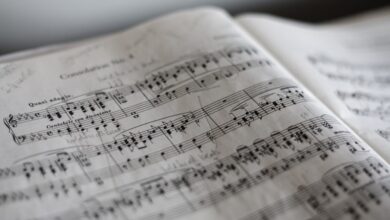The Global Spread of the Accordion: From Europe to the Americas and Beyond

The global spread of the accordion has been nothing short of remarkable, captivating audiences from Europe to the Americas and beyond. This fascinating musical instrument has traversed continents, cultures, and time, leaving an indelible mark on the world of music.

Originating in Europe during the early 19th century, the accordion quickly gained popularity due to its unique sound and portability. Its compact design allowed musicians to carry their melodies wherever they went, making it a favorite choice among traveling performers. From bustling streets to grand concert halls, the accordion found its place in the hearts of both musicians and listeners alike.
As waves of European immigrants set sail for the Americas, they carried with them not only their hopes and dreams but also their beloved accordions. The instrument seamlessly integrated into the rich tapestry of American music, finding its way into genres like jazz, folk, and polka. In the hands of skilled musicians, the accordion added a vibrant and unmistakable flavor to popular tunes, creating a fusion of cultures that resonated with audiences across the continent.

But the accordion’s influence didn’t stop there. It continued its global journey, enchanting listeners in countries as diverse as Argentina, Russia, and China. Each region embraced the accordion and incorporated it into their traditional music, infusing new life into age-old melodies. From the tango rhythms of Buenos Aires to the soul-stirring ballads of Eastern Europe, the accordion’s versatility transcended borders and language barriers.
What makes the accordion truly remarkable is its ability to evoke emotions in a way no other instrument can. Its expressive power allows musicians to paint vivid musical landscapes, transporting listeners to distant lands or stirring memories of their own heritage. Whether played solo or as part of an ensemble, the accordion weaves tales of joy, melancholy, and everything in between.
Today, the accordion remains a beloved instrument, cherished by musicians and enthusiasts worldwide. Its distinct sound and global journey symbolize the interconnectedness of cultures, reminding us of our shared humanity. So, next time you hear the soulful strains of an accordion, let yourself be carried away on a musical adventure that spans continents and transcends time.
Unveiling the Accordion’s Global Journey: How this European Instrument Captivated the Americas and Beyond
Have you ever wondered how a small instrument from Europe managed to captivate audiences across the globe? The accordion, with its magical sound and mesmerizing melodies, embarked on a fascinating journey that spanned continents, winning hearts wherever it went. In this article, we will delve into the captivating story of the accordion’s global conquest.
Originating in Europe during the 19th century, the accordion quickly became a beloved instrument in countries like Germany, Italy, and France. Its unique design, featuring a set of bellows and a keyboard, allowed musicians to produce a wide range of sounds, creating an enchanting musical experience like no other.
As time passed, the accordion’s popularity soared, and it eventually found its way to the Americas. Immigrants from European countries brought their cherished accordions with them as they sought new opportunities in the New World. It didn’t take long for this remarkable instrument to weave its way into the fabric of American music.
In the United States, the accordion found a new home in genres such as folk, country, and jazz. Its versatility allowed musicians to infuse their own cultural influences into the music, creating a rich fusion of styles that resonated with diverse audiences. From the lively polkas of the Midwest to the soulful melodies of the Deep South, the accordion became an integral part of the American musical landscape.
But the accordion’s journey didn’t stop there. Its infectious rhythms and expressive tones transcended borders, making it a global sensation. In Latin America, the accordion found its place in traditional genres like tango and vallenato, adding a vibrant flair to the already exuberant music of the region. Similarly, in countries like Russia, China, and India, the accordion adapted to local traditions, merging seamlessly with indigenous instruments and melodies.
Today, the accordion continues to enchant people worldwide. Its ability to evoke a range of emotions, from joy to melancholy, is unparalleled. Whether it’s played in intimate cafes, grand concert halls, or lively street performances, the accordion carries with it a sense of nostalgia and cultural heritage.

The accordion’s global journey is a testament to the power of music to transcend borders and capture the hearts of people from different cultures. From its humble origins in Europe to its widespread influence in the Americas and beyond, this unassuming instrument has left an indelible mark on the world of music. So, the next time you hear the soul-stirring strains of an accordion, take a moment to appreciate the fascinating story behind its captivating journey.
From Polkas to Tango: Exploring the Diverse Musical Legacy of the Accordion Around the World
The accordion, a versatile and captivating musical instrument, has left an indelible mark on the global music scene. Its unique sound and expressive nature have made it a beloved instrument in various genres across different cultures. From lively polkas to passionate tangos, the accordion’s diverse musical legacy continues to inspire and enchant audiences worldwide.
When we delve into the world of polkas, the accordion takes center stage with its infectious rhythm and lively melodies. Originating in Eastern Europe, this energetic dance music quickly spread throughout the globe, becoming a staple of celebrations and gatherings. The rhythmic pulse of the accordion sets the pace, inviting people to kick up their heels and join in the merriment.
Venturing further into South America, we encounter the sultry embrace of the tango, a genre teeming with passion and sensuality. The accordion’s expressive capabilities shine brightly in this musical style, conveying the raw emotions and longing that define the tango. Its melancholic tones intertwine with the soulful melodies, creating an enchanting ambiance that captivates listeners and transports them to the streets of Buenos Aires.
But the accordion doesn’t limit itself to these popular genres alone. It seamlessly finds its place in various musical landscapes around the world. In Celtic music, the accordion adds a lively and spirited dimension, harmonizing effortlessly with fiddles and bagpipes. In Cajun and Zydeco music, it infuses a distinct flavor, evoking the vibrant culture of Louisiana.
Moreover, the accordion has played a significant role in both traditional and contemporary folk music across Europe, Asia, and even Africa. It has become an emblem of cultural identity, with each region putting its own spin on the instrument’s unique timbre and playing techniques.
The accordion’s rich and diverse musical legacy spans continents and genres. Its ability to evoke emotions, create a sense of nostalgia, and ignite joy is unparalleled. Whether it’s the spirited polka, passionate tango, or any other musical style, the accordion’s enchanting melodies continue to resonate with listeners worldwide, ensuring its place as a cherished instrument in the hearts of music lovers everywhere.
Cultural Crossroads: The Surprising Influence of the Accordion on Traditional Music Across Continents
Have you ever wondered how a seemingly humble musical instrument like the accordion could wield such a profound influence on traditional music across continents? Prepare to be amazed as we delve into the captivating world of cultural crossroads and discover the surprising impact of the accordion.
In the realm of traditional music, the accordion stands as a true marvel, effortlessly blending harmonies and rhythms from different corners of the globe. Its versatility knows no bounds, transcending cultural boundaries and breathing new life into age-old melodies. From the lively polkas of Eastern Europe to the soul-stirring tangos of Argentina, the accordion’s presence is felt far and wide.
One might ask, how did this unassuming instrument make its way into such diverse musical traditions? Like a fearless explorer, the accordion embarked on a journey, traversing continents and weaving itself into the fabric of cultures along the way. It found its place in European folk music, where its enchanting melodies resonated with the hearts of the people. Soon, it crossed the Atlantic and made its mark in the vibrant tapestry of Latin American music, infusing it with its distinctive sound.
The accordion’s ability to express a wide range of emotions is truly remarkable. Whether it’s conjuring up images of joyous celebrations or evoking feelings of melancholy, this instrument captivates listeners with its expressive power. In the hands of a skilled musician, the accordion becomes a vessel through which stories are told and emotions are shared.
Imagine a bustling Parisian café, where the accordion’s playful tunes mingle with the clinking of glasses and lively conversations. Picture yourself strolling through the streets of New Orleans, where the soulful sounds of jazz emanate from every corner, accompanied by the rhythmic squeeze of an accordion. These scenes depict just a fraction of the accordion’s immense impact on the cultural landscapes it has touched.
The accordion’s surprising influence on traditional music across continents is a testament to the beauty of cultural exchange. As it dances between genres, styles, and traditions, this extraordinary instrument unites people through the universal language of music. So next time you hear the enchanting melodies of an accordion, take a moment to appreciate the rich tapestry of cultures it represents and the wonders of our interconnected world.
Accordion Revival: How an Old Instrument Finds New Life in Contemporary Music Worldwide
Have you ever heard the mesmerizing sound of an accordion? This old instrument, with its distinctive bellows and keys, has found a new lease on life in contemporary music around the world. In this article, we’ll delve into the resurgence of the accordion and explore how it is making a remarkable revival.
The accordion, often associated with traditional folk music, has been captivating audiences for centuries. Its versatility allows it to create a wide range of sounds, from delicate melodies to vibrant rhythms. But what makes the accordion truly fascinating is its ability to blend seamlessly with various musical genres, transcending cultural boundaries.
In recent years, musicians and composers have embraced the accordion’s unique charm and incorporated it into their works, breathing fresh life into contemporary music. From indie rock bands to experimental electronic artists, the accordion has become a staple instrument, adding depth and richness to compositions.

One of the reasons behind the accordion’s resurgence is its ability to evoke nostalgia while remaining relevant in modern times. Its distinct timbre instantly transports listeners to another era, invoking memories of lively village festivals or intimate gatherings. At the same time, its integration into contemporary arrangements creates an intriguing juxtaposition that captivates the audience’s attention.
Moreover, the accordion’s portability and accessibility contribute to its growing popularity. Unlike larger instruments, such as pianos or drums, the accordion can be easily carried and played in various settings. This mobility allows musicians to experiment with different spaces and atmospheres, pushing the boundaries of traditional performance venues.
Contemporary music around the world has witnessed the accordion’s revival on a grand scale. From the streets of Paris, where buskers fill the air with harmonious tunes, to avant-garde music festivals in Berlin, where experimental accordionists challenge conventional norms, the instrument’s influence continues to expand.

The accordion’s resurrection in contemporary music is nothing short of extraordinary. Its timeless appeal, versatility, and portability have propelled it into the limelight once again. As musicians continue to explore new horizons, we can only anticipate the accordion’s continued growth and its enduring impact on the global music scene.




